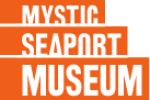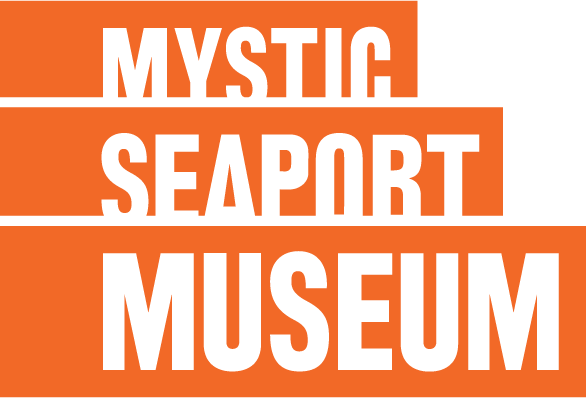Category: News
Read the latest Mystic Seaport news.
News from the Collections Blog
Mystic Seaport Museum on YouTube

Health & Safety Update
Mystic Seaport Museum remains closed to the public as we collectively work to halt the spread of the COVID-19 virus. This action is in keeping with our commitment to maintaining a healthy and safe environment, as well as with our responsibility to follow directives from the Federal and local governments.
Although we are closed to visitors, the business of the Museum goes on. Many of our staff members are able to telecommute and work from home, so if you have a matter that needs our attention, please do not hesitate to reach out via phone or email.
We will continue to keep visitors updated as this rapidly changing situation evolves. We appreciate your support during this difficult time and we look forward to inviting you back for a visit when we reopen.
Resources
- Centers for Disease Control and Prevention: Coronavirus (COVID-19)
- World Health Organization: Coronavirus (COVID-19)
- State of Connecticut Coronavirus Portal
- State of Connecticut Coronavirus FAQ
Looking for Something to Do?
Over the next several weeks we will be posting new content on our website and social media to help everyone pass the time. In the meantime, we encourage you to check out our Stories Blog which has a large collection of Museum videos. You may also want to peruse our Mystic Seaport Museum for Educators website. It has a wide variety of resources about our collection that can be of interest to the general audience as well as teachers.
Here is one of our favorite videos from the 38th Voyage of the Charles W. Morgan in 2014:
[embedit snippet=”atop-the-world-morgan-video”]
The Museum announced today it is temporarily closing to the public beginning tomorrow, March 13, to support the State of Connecticut’s efforts to stem the outbreak of COVID-19. All programs, classes, and events during that period are also cancelled. The Museum anticipates reopening March 30, subject to further evaluation of the situation.
Steve White, president of the Museum, stated: “Out of an abundance of caution we are taking this preemptive move to close to the public to protect the health of our community and of our employees and volunteers. We have been following the precautionary measures recommended by federal and local health authorities to ensure the cleanest environment possible. While we do not know of any exposure to COVID-19 connected with the Museum, we believe a temporary closure is the proper course of action in line with Gov. Ned Lamont’s request to minimize public gatherings and encourage employees to work from home to help stop the spread of this deadly virus. We look forward to welcoming visitors back to the Museum at the conclusion of this period.”
Individuals or groups with program reservations during this time will be contacted to reschedule or process refunds.
The Museum is implementing its emergency operations protocol, and will continue to monitor the situation and take appropriate additional action as necessary.
Coronavirus Update
Mystic Seaport Museum is following the recommendations of the Centers for Disease Control and Prevention (CDC), the Connecticut Department of Public Health, and the local health authorities pertaining to the Coronavirus outbreak. We are actively monitoring the situation and implementing recommended policies.
We are presently open to the public and we have not cancelled any classes, workshops, or programs. The Museum’s operating hours remain Thursday-Sunday, 10 a.m.-4 p.m.
We suggest all members of the public follow the CDC’s suggested precautions, including staying home if they feel sick or have other health concerns, and frequently washing their hands.
Should the need arise to cancel or postpone any of our programming, or close the Museum to the public, we will make the announcement through the appropriate communication channels, including (but not limited to) our website, social media platforms, and direct communication with individuals registered for a class or workshop.
Town Approves Hotel Project
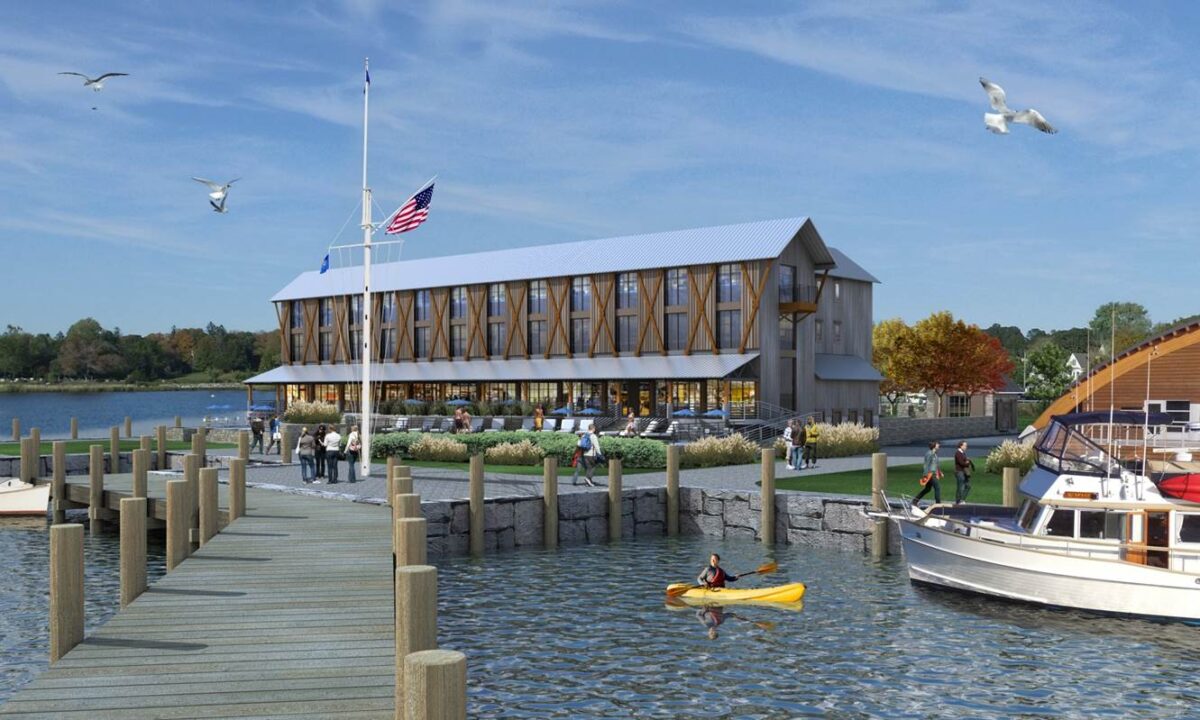
The Town of Stonington Planning and Zoning Commission approved the proposed Delamar hotel at a special meeting March 3. The decision paved the way for the demolition of Latitude 41° Restaurant and the construction of a new boutique hotel and restaurant.
The three-story, 27-room boutique hotel and restaurant, to be called the Delamar Mystic, will be located further back on the property closer to the Mystic River. The space now occupied by Latitude 41° will be converted to a circular driveway with valet parking. Architect Bruce Beinfield of Norwalk, CT, who cited the area’s grand beach hotels of the 19th century as his inspiration, designed the building.
The developer for the project is Greenwich Hospitality Group, which will lease the property from the Museum. The company’s founder and chief operating officer is Charles Mallory, who was a longtime trustee of the Museum. Greenwich Hospitality Group operates Delamar hotels in Greenwich, Southport, and West Hartford.
The Museum built the Latitude building in the mid-1960s as a restaurant. In addition to issues associated with the structure’s age, it suffers from regular flooding and it was determined the best course forward would be to replace the building and not renovate it.
Plans call for Latitude 41° to be razed in early 2021 followed by a groundbreaking for the hotel. Construction will continue into 2022.
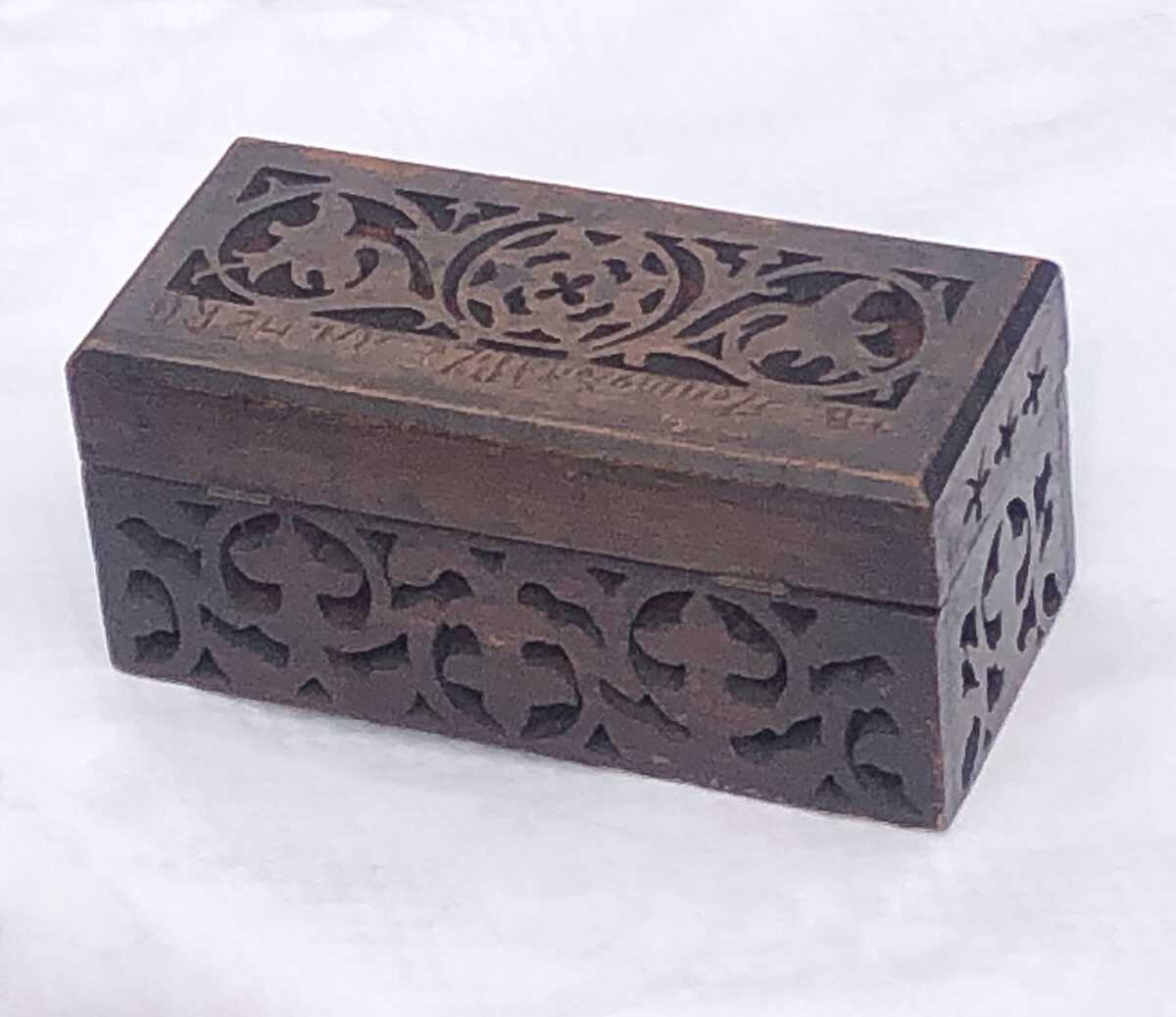
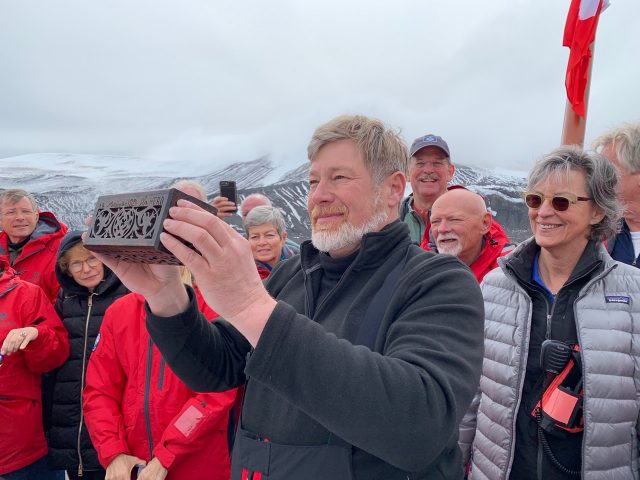
DECEPTION ISLAND — When Nathaniel’s Palmer’s sloop Hero anchored at Deception Island on that fateful day in 1820 when it is thought that Palmer first saw the continent of Antarctica, a small sailor’s ditty box was along for the ride. Two hundred years later, that same box – now in the Museum’s collection – made the trip back to the very same harbor.
The trip was the idea of Museum trustee Alex Bulazel, who has traveled to Antarctica and the Arctic many times. It was Bulazel who called attention to the 200th anniversary of Palmer’s sighting of the continent.

Bulazel, Museum president Steve White, and 12 other people with ties to Mystic Seaport Museum were part of a group of 186 passengers on the ship Le Lyrial on a cruise to Antarctica in January to visit sites connected to the Palmer bicentennial. The expedition was organized by the luxury travel company Abercrombie & Kent. Glenn Gordinier, co-director of the Museum’s Munson Institute, was on board to give talks on the history of the Palmer story and Antarctica.
Palmer and a crew of four were on a sealing expedition on the 47-foot Hero. While anchored in Whalers Bay on Deception Island, Palmer went ashore and climbed a hill where he saw the continent of Antarctica for the first time on November 17, 1820. Two other expeditions led by the Russian explorer Fabian Gottlieb von Bellinghausen and Englishman Edward Bransfield also sighted the continent earlier in the year.
The 7″ x 3″ wooden ditty box was donated to the Museum in 1950. It is ornately carved and has an inscription, “L.B. Stonington Slp. Hero.” The L.B. probably stands for Stanton L. Burdick, who was 16 at the time. Ditty boxes were carried by sailors, who would keep special items and personal remembrances in them during their time at sea.
Amtrak Offers Additional Service to Mystic
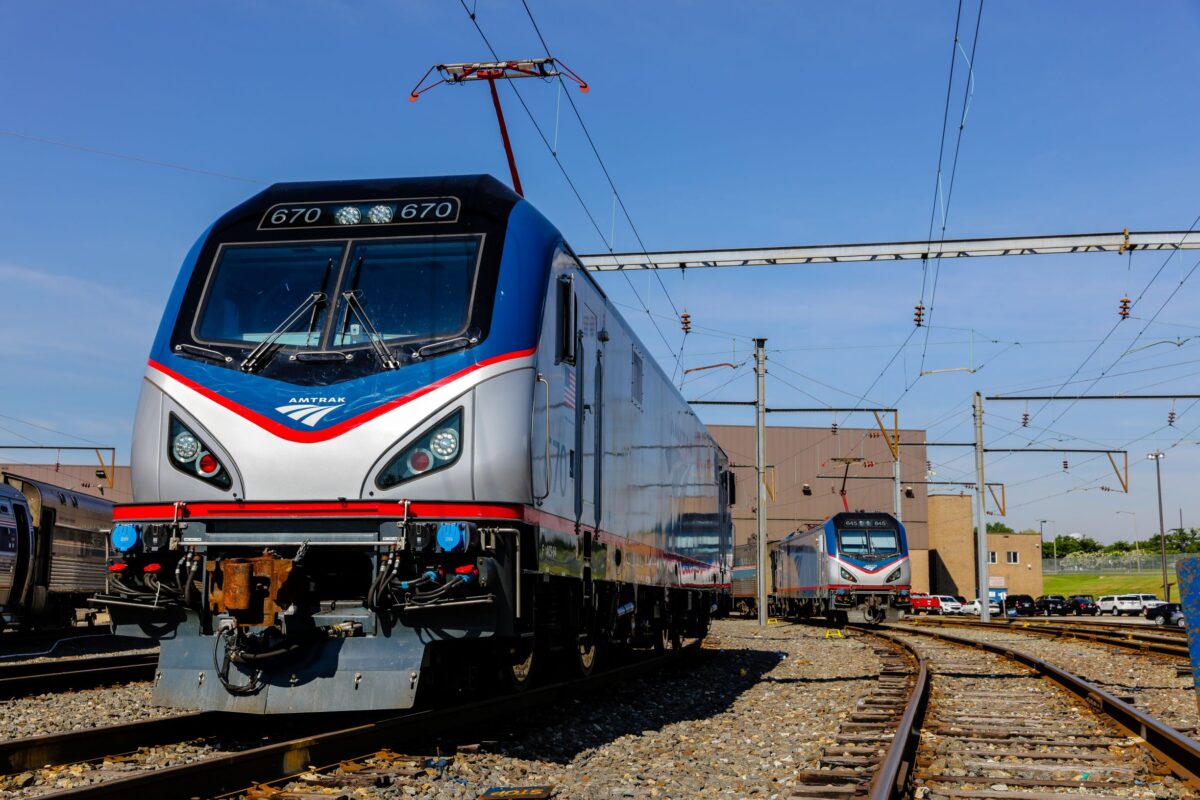
NEW YORK – Amtrak continues to prioritize upgrading the customer experience as travelers along the Northeast Corridor (NEC) will now benefit from increased weekday service on Northeast Regional trains at popular stations in Mystic, CT, and Westerly, R.I., to receive more access to the region’s major markets. The new schedule, which largely alternates trains at these stations to provide more meaningful service, will go into effect beginning Monday, March 16, 2020.
There will be four additional stops on Southbound trains and three additional stops on Northbound trains.
“By providing additional service for Mystic and Westerly, travelers and residents will reap the benefits of a more efficient travel experience,” said Amtrak President and CEO Richard Anderson. “The benefits will also expand beyond these two stations as it allows Amtrak to better serve populations and cities along the NEC by offering additional access to and from urban areas in Boston, New York, and Virginia.”
Weekday Southbound trains will now stop at Westerly and Mystic at the following times (new service highlighted in red):
| Train Number | Westerly, R.I. | Mystic, CT |
| 95 | 7:20 a.m. | 7:30 a.m. |
| 171 | – | 9:37 a.m. |
| 93 | 10:38 a.m. | – |
| 173 | – | 12:38 p.m. |
| 137 | 2:56 p.m. | – |
| 175 | – | 4:39 p.m. |
| 177 | 6:53 p.m. | – |
| 179 | – | 8:08 p.m. |
| 65/67 | 11:05 p.m. | 11:17 p.m. |
Weekday Northbound trains will now stop at Westerly and Mystic at the following times:
| Train Number | Mystic, CT | Westerly, R.I. |
| 66 | 5:49 a.m. | 6:01 a.m. |
| 190 | – | 9:55 a.m. |
| 170 | 11:21 a.m. | – |
| 172 | – | 1:55 p.m. |
| 86 | 3:16 p.m. | – |
| 174 | – | 4:56 p.m. |
| 176 | 6:40 p.m. | – |
| 94 | – | 8:44 p.m. |
| 178 | 10:45 p.m. | 10:55 p.m. |
In addition to the customer benefits and improvements to quality of travel via the expanded service, Amtrak also remains committed to continuous improvement and innovation throughout the entirety of its rail network, on its trains and at its stations. Amtrak recently announced the expansion of its popular assigned seating offering in Business Class for Northeast Regional trains, which provides a more seamless onboarding process and the option for customers to select their preferred seat. Northeast Regional trains, as part of Amtrak’s NEC fleet, are also the country’s only all-electric intercity trains, providing a more environmentally friendly way to travel as part of Amtrak’s goal to reduce its carbon footprint.
There are no changes to weekend trains at this time; Schedules are subject to change. Tickets are now on sale on Amtrak.com, the Amtrak app, via our ticket agents or by calling 1-800-USA RAIL.
Source: Amtrak press release.
A Second Motor for Sabino
Mystic Seaport Museum is exploring the possibility of adding electric propulsion to its steamboat Sabino with the installation of an electric motor and battery bank. The boat’s boiler and its original steam engine would remain in the vessel and operational. The addition of electric power would enable the vessel to operate under steam or electricity and vastly expand its capacity to provide public cruises on the Mystic River.
“In order to keep Sabino running on the Mystic River, we have determined that the highest and best solution for the vessel, both as a National Historic Landmark and as a beloved presence on the Mystic River, is to add an alternative means of propulsion to augment its historic steam power plant,” says Steve White, president of Mystic Seaport Museum.
The plan calls for state-of-the-art, batteries, motors, and controls to be installed in parallel with the existing boiler and steam plant. The Museum will retain the ability to run Sabino under steam, but add the capability to run on electric power.
The 1908-built excursion vessel Sabino has been a fixture at Mystic Seaport Museum and on the Mystic River since its arrival in 1973. Built in Maine as a passenger ferry on the Damariscotta and Kennebec Rivers, the boat served in that capacity for nearly two decades and later as a ferry in Casco Bay. It is powered by the same duplex reciprocating steam engine that was original equipment in 1908. In fact, the engine was manufactured downriver from Mystic in nearby Noank. With its nearly silent steam propulsion, a cruise down the Mystic River on Sabino is a connection to the past when small steamboats filled the nation’s coasts and harbors. The boat was designated a National Historic Landmark in 1992.
In partnership with a team of marine engineers and the U.S. Coast Guard, the Museum determined that an electric system could be installed in such a way as to fully maintain the historic operational integrity of the vessel’s original steam power plant. Sabino would continue to operate the steam plant for demonstrations and special events, but operate under electric power for daily passenger cruises. The electric motor would quietly drive the vessel’s original shaft. Batteries would be recharged overnight and between trips. Importantly, this system would provide a smoke- and soot-free operation, greatly reducing the vessel’s environmental impact in terms of carbon emissions. Other benefits include a return to a seven-day per week schedule, and reduced crewing, maintenance, and coaling expenses.
The historic status of Sabino is paramount to the Museum. The historic fabric of the boat will not be altered and the installation of the electric system would be entirely reversible.
“The expectation is the addition of electric propulsion will enable us to increase the boat’s daily passenger capacity and provide more people with the opportunity to get out on the water and enjoy a cruise on the Mystic River on a National Landmark,” says White.
